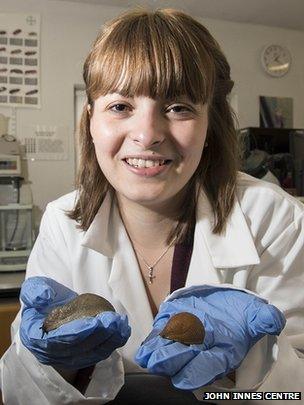Spanish slug invasion: Scientists seek public's help
- Published

Rachel Ayers designed the Slugwatch website and created cards identifying different species of slug
Scientists are asking for the public's help to track the spread of a greedy slug species threatening to eat its way through British gardens and crops.
The Spanish slug was first reported in the UK in January by Dr Ian Bedford, head of entomology at the John Innes Centre, Norwich.
It can survive many slug pellets, eats crops spared by native species and tolerate drier conditions.
A red-brown colour, pale or rich, can identify a suspected Spanish slug.
Scientists fear it could breed with our native species to form a hybrid.
The Iberian invader, Arion vulgaris, can reproduce in greater numbers and has unappealing habits, including eating dead animals and excrement.
During the winter, many disappeared underground or died but their eggs survived and the species may have returned in greater numbers.
Scientists are asking people to look for the slugs under logs and plant pots in their gardens, and record and photograph their findings using a dedicated SlugWatch, external website.
"We want photos and sightings from members of the public to help build a picture of how widespread the Spanish slug has become," said Dr Bedford.

The Spanish slug can survive many slug pellets and tolerate drier conditions that native slugs
"The reports may also give us an idea of whether it is breeding with our native species to form a hybrid combining the worst of the Spanish slug with tolerance to frosts and cold from our own species."
'Can't be controlled'
Keith Norman, technical director of farming company Velcourt, said farmers were using up their entire allowance of slug pellets early in the season, leaving no other means of control.
"It is a disaster waiting to happen if the Spanish slug proliferates and establishes itself in the UK," said Mr Norman.
"The Spanish slug causes more eating damage and cannot be controlled with existing measures."
The Slugwatch website was designed by Rachel Ayers, 17, a sixth-former at at Notre Dame High School. Norwich.
She also designed cards identifying different species of slug for use in schools.
"We want people to survey their gardens, local areas and school grounds for slugs, or they can build a trap using instructions on the site," she said.
"One of the most interesting parts of the project was learning about slugs and how to identify them," said Rachel.
There are 30 native species in the UK, four of which are classed as pests: the netted or grey field slug, the garden slug, the keeled slug and the large black slug.
Slugs play an important role in the ecosystem. They are natural composters, breaking down vegetation, and provide food for hedgehogs, toads and some garden birds.
"We hope that as well as helping with research into the Spanish slug, people will learn a bit about the biology of these molluscs," said Dr Bedford.
"You never know, we may even help inspire someone to become a malacologist in the future."
- Published10 January 2013
- Published4 July 2012
- Published12 June 2012
- Published22 August 2011